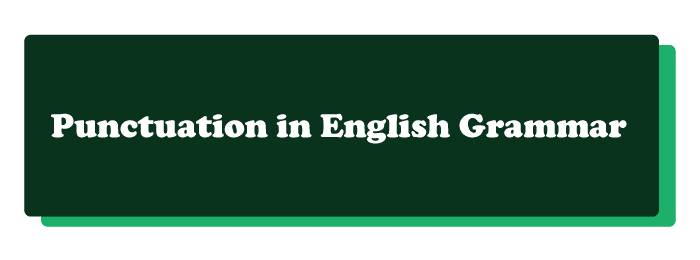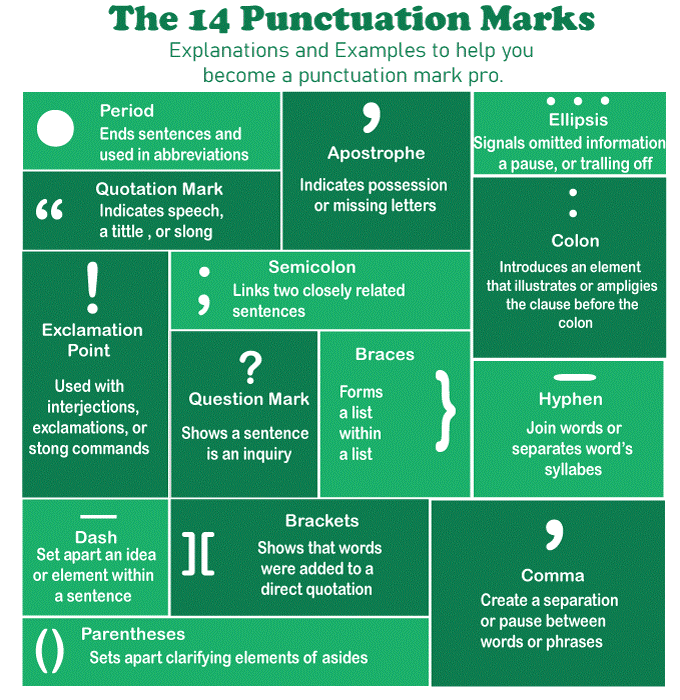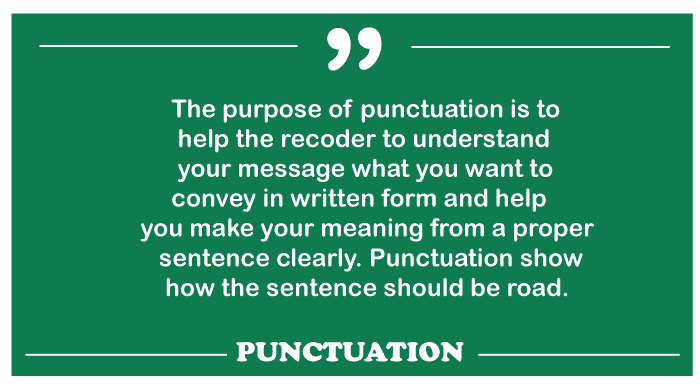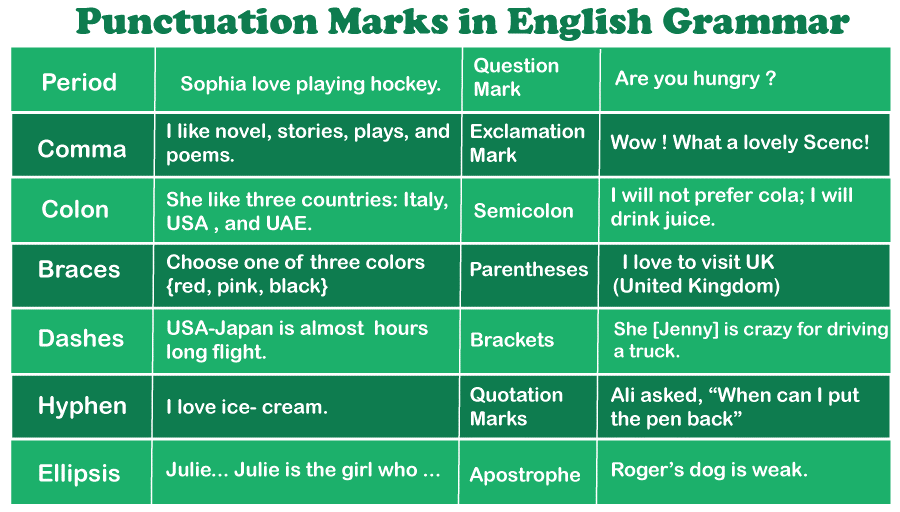Punctuation in English GrammarWhat is Punctuation? - Definition and MeaningPunctuation is as crucial, if not more so, than the terms you use, the structure of your statements, and the subject you are attempting to portray. Punctuation implies to the mechanism that permits a writer to notify the reader where sentences conclude, if there is a brief or lengthy pause, and if the author is asking, explaining, or offering additional information. When the author is not directly talking to the audience, punctuation is the only means for the reader to understand what the author is saying. 
What is the Significance of Punctuation?Punctuation is vital since it directs the flow of your text. If your writing is a highway, punctuation marks are the stop signs. They demonstrate to the reader where or how to pause, where to stop, and how to understand the sentences they encounter. Various types of punctuation can drastically alter the message of your work. Consider the following example, which you may have encountered before: Let's cook Grandmother . Let's cook, Grandmother . Notice the difference that a comma makes ? 
English Grammar Punctuation MarksSeveral punctuation marks are employed in English grammar to make your work appear logical and easy to read. A punctuation mark is described as "a sign or mark used throughout writing to divide sentences and phrases", as per Oxford Learner's Dictionary. Let's look at the different punctuation marks in English grammar.
It is also critical to realise that capital letters and spaces are an important aspect of punctuation. 
A Complete Guide to PunctuationPunctuation is an important instrument in English Grammar that assists us to arrange our thoughts and make them easier to analyze and share. Full stop , comma, apostrophe, quote, question mark, exclamation mark, brackets, braces, parenthesis, dash, hyphen, ellipsis, colon, semicolon are some of the common and fundamental English punctuation marks. The next section provides a description of some often-used punctuation. Comma (,)Commas are mostly used to add clarity and to connect two separate sentences with a conjunction. They start with introduction sentences and series. They are additionally utilized to distinguish between independent and dependent sentences. The Oxford comma is a comma placed before a coordinating conjunction in a sequence. Examples:
In a sentence, commas may be utilized as well to indicate an interjection. For instance, the offender claimed that the judge was dumb. The offender, said the judge, was dumb . In the first sentence, the perpetrator speaks. In the second, the judge is speaking. Apostrophe (')The apostrophe is a small, crowded punctuation symbol. It appears as follows: ' Apostrophes' functions include: Forming possessive nouns (for example, John's house and the Kelleys' automobile) Making contractions out of words (don't, she'll, weren't) More casually, apostrophes are utilized to shorten words (government becomes gov't, and the 1970s then becomes '70s) and in quotations to indicate that the speaker has reduced a term, as in: We searched and found nothing. One more point on apostrophes: they are rarely used to pluralize nouns. For instance: When alluding to a decade numerically (absolutely right: the 1990s, absolutely wrong: the 1990's), avoid using them. The Use of Question Marks (?)Another one-purpose punctuation symbol is the question mark. They are represented as ? They're also used to indicate that a statement is a question. Only use a question mark when asking a straight inquiry, such as:
Since indirect questions are declarative statements, they terminate with periods. Indirect inquiries include the following:
Dashes (?)There are two types of dashes that you presumably use rather frequently in your writing?and one that you don't. The two most frequent are: Em dash ? En Dash - Em dashes are used to separate information from the remainder of the sentence. They can also be used to emphasise a word or phrase. Based on your style guide, you can put a space on either side of an em dash. Setting off information - My best buddy, whom I've known since I was a child ? is leaving. For emphasis - The house was lovely ? but spooky. En Dash ( - ) En dashes are shorter than em dashes and are used to express a range or link between numbers or sentences. There is no requirement for using space on either side of an en dash. Indicating range - The American Civil War (1861-1865) had a long-lasting impact on the country. When is the Colorado- Vancouver flight scheduled to arrive? A double hyphen is an unusual occurrence. It appears as follows: ? You only use it to wrap a hyphenated term onto the following line of text. Quotation marks (-....")Quotation marks, as the name says, represent direct quotes. Nevertheless, that's not all doctors do. They resemble " " and may also be applied to: (His essay, "Why Choc is the Greatest Taste," was featured in Ice Cream magazine.) Indicate a term within a statement (For example, "winner" for the championship.) Indicate that a particular word is being used in a sarcastic disapproving manner (The day-old pie was "not that bad.") Parentheses ( )When you require to add information to a statement but it doesn't fit in smoothly, use parenthesis. This information is usually a nugget of detail or a brief aside. Additional consideration: John and Jane (brother and sister) both have blue hair. Qualifying remarks- Include any particular abilities (typing, organising, training, etc.) on your cv. Hyphens (-)Hyphens may appear to be dashes, but they are not. Hyphens are used to form complex words such as:
Commonly Used Punctuation SymbolsInterrobang ?What? The interrobang is the punctuation mark you use when your statement requires a question mark and an exclamation mark. It was first presented in 1968 and is now available in a wide range of fonts. Brackets ([] ; {})Brackets may appear to be parenthesis, but they are not. They are available in two varieties: [] in square brackets Curly brackets, often called as braces or squiggly brackets, are as follows: { } Square brackets are utilized in two ways: to add material to a quote to clarify it, and to denote a subordinate clause within another subordinate clause within parenthesis. If that sounds unclear, perhaps seeing them in action will help: They should not be used if the final letter is followed by an apostrophe (correct: don'ts, incorrect: don't's). When discussing a group of individuals, avoid using them (correct: the Sheenas are coming to supper, incorrect: the Sheena's are coming for a meal). However, an apostrophe can only be utilized to pluralize a noun if the noun having pluralized is a lowercase character. For instance: Watch the p's and q's. Exclamation Marks (!)Punctuation is enthralling! Since it is finished with an exclamation point, you read the line with zeal and vigour:! The exclamation mark, like the period, has a single purpose: to make statements exciting! Just be careful not to misuse them, and in some cases, it's best to avoid them totally. Exclamation marks can be entertaining in casual messages and can reflect the emotion in a character's voice while writing fiction, but they are rarely appropriate in professional, academic, or business writing. "I really enjoyed [the new film]. "I couldn't take my eyes off her," Robert said. I called my family (Mum, Dad, my sisters [only Seema came] and Grandmother) to come see the golden retriever. Outside of computing, physics, and high-level arithmetic, squiggly brackets are uncommon. But, when they are, they are usually used to signify a list. Periods (.)Periods are among the most fundamental punctuation signs. The period, commonly known as the full stop, appears as follows:. It only serves one purpose: to terminate a declarative phrase. That's all there is to it. Periods are responsible for this. Ellipses (...)Ellipses resemble a group of three periods:... An ellipsis indicates that material has been omitted from a quote, usually to make it shorter. They're also utilised in fiction and poetry to create suspense, indicate a presenter's voice trailing off or failing, or indicate incomplete thoughts. This grew into the use of ellipses in casual discourse, such as text messages and postings to social media, where they're commonly employed to symbolise pauses... or voices or thoughts drifting away. Semicolon ( ; )Semicolons join independent clauses to indicate a closer connection than a full stop would. They can also be used to divide items in a list which already includes commas. Linking independent clauses - John was wounded ; he knew she said it to irritate him. In another examples. Here are items in the list- I've visited Agra, India; Los Angeles, Usa; and France, Europe. Colon ( : )Colons begin a quotation, explanation, example, or series. They can also be used to clarify info or to accentuate a key word or phrase. Introduction of new series - He intended to major in four subjects: law, philosophy, psychology, and economics. Clarification: I didn't have time to change: I was already late. Putting emphasis on a crucial phrase - There was one thing she liked more than everything else: Her car. 
Punctuation TypesPunctuation marks are classified as per their function. Terminal LocationsTerminal points are punctuation marks that come at the end of statements. These are the marks:
Points Of Pause/ Pausing PointsPausing points are punctuation marks that instruct the reader to take a breather. These are some examples:
Recognizing A QuoteNext are the punctuation marks used to indicate quotations. This category contains quotation marks. Common Punctuation Questions and MistakesWhat Is the Appropriate Number of Spaces After a Period?One space is appropriate after a period when using a computer. If you learned to type on a typewriter, you were likely taught to use two spaces after a period because each character took up the same amount of space on the page, and two spaces made it easier to identify the start of a new sentence. When Should I Use a Colon Versus a Semicolon?Knowing when to use a colon or semicolon can be challenging, and there are situations where either may be appropriate. Generally, a colon is used when introducing information and providing context or when emphasizing the second of two related clauses. On the other hand, a semicolon is used to join two independent clauses together as a complete sentence. What Is the Oxford Comma, And Should I Use It?The Oxford comma, also known as the serial comma, is a comma placed in a list between the second-to-last item and the word -and." Some style guides require its use, while others do not. The Oxford comma can make lists clearer by removing ambiguity regarding the final two items. However, consistency in its use is essential when writing. Should I Use Single or Double Quotes, And Where Do I Place Punctuation Marks?In American English, double quotes are generally used, except when writing a quotation within a quotation. In British English, single quotes are typically used. Punctuation marks like periods and commas always go inside quotation marks in American English. However, not all punctuation marks go inside quotation marks, and the placement of dashes, colons, and semicolons depends on whether they are part of the quote or the larger clause. With parentheses, the punctuation mark's placement depends on whether it is part of the sentence or clause within the parentheses or the larger sentence. Should Periods Be Positioned Inside Quotation Marks? How About in Parentheses?In American English, periods should always be placed inside quotation marks, as should commas. However, other punctuation marks such as dashes, colons, and semicolons should always be placed outside quotation marks, unless they are part of the quoted material. Exclamation and question marks may be placed inside or outside quotation marks, depending on whether they belong to the quote or the larger sentence. Here are examples of both scenarios: "How much do I owe you?" Jenna asked the shopkeeper. I want a sausage, not this "synthetic substitute"! The same rules apply when using parentheses. If the period or any other punctuation mark belongs to the sentence or clause within the parentheses, it should be placed inside the parentheses. However, if it belongs to the larger sentence, it should be placed outside the parentheses. How Can I Ensure I'm Using Punctuation Correctly?One way to catch punctuation mistakes is by reading your writing aloud. As reading them again and again can help you identify and correct any punctuation errors in your writing. Rules Of Punctuation MarksHere is a more detailed description of how to use each common punctuation mark: A. Full Stop/Period Usage
B. Comma Usage
C. Semicolon Usage
D. Using A Colon
E. Question Mark Usage
F. Exclamation Mark Usage
G. When to Use Quote Marks
H. Parenthetical Usage
I. Bracket Usage
J. Usage of Hyphen
K. Dash Usage
It is crucial to remember that punctuation standards may differ slightly based on the style guide used, such as MLA, APA, or the Chicago Manual of Style. It's always a good idea to reference a style guide for more particular punctuation requirements.
Next TopicEnglish Grammar Rules
|
 For Videos Join Our Youtube Channel: Join Now
For Videos Join Our Youtube Channel: Join Now
Feedback
- Send your Feedback to [email protected]
Help Others, Please Share










